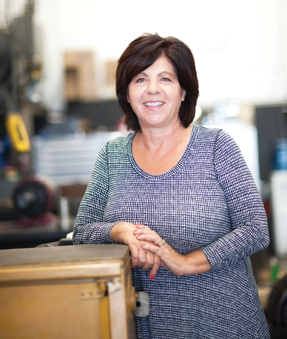Using technology to reach customers
 Apex Industrial Automation embraces innovation and change to serve evolving customer needs
Apex Industrial Automation embraces innovation and change to serve evolving customer needs
by Rich Vurva
The business that Ryan Watts acquired in 2006 looks considerably different today compared to when he bought it more than a decade ago.
Evolving customer buying preferences and new technologies have resulted in dramatic changes. Ten years from now, the company will likely look nothing like the Apex Industrial Automation of today. After spending just a few minutes listening to this high-energy entrepreneur talk about his company, it’s abundantly clear that he abhors the status quo. Watts will settle for nothing less than continually striving for innovation in an effort to satisfy the needs of customers.
One of the first changes Watts made after acquiring Apex Power Equipment in Downers Grove, Illinois, was to change the name.
“Our name made us sound like a lawn mower repair shop,” Watts jokes.
The current name more appropriately describes the world-class service organization that Watts intends his business to become.
Within a few years of buying Apex, he made four additional acquisitions of companies in the Chicago and downstate areas to bring in additional expertise.
The first brought Peoria Bearing in Peoria, Illinois, into the fold, followed in quick succession by acquisitions of Industrial Motor Service in Montgomery, Illinois, and Jay’s Electric in Steger, Illinois, both of which added motor, gearbox and pump repair capabilities, and then Control Headquarters of Crest Hill, Illinois, a distributor of industrial controls that offers full control panel engineering, design and fabrication.
 “We’ve been able to succeed and grow based on acquisitions, based on hard work, and on grinding it out in hand-to-hand combat in the trenches,” Watts explains. He anticipates the pace of change to accelerate, and predicts that the company’s annual sales of $12 million will blossom to about $50 million within the next 10 years.
“We’ve been able to succeed and grow based on acquisitions, based on hard work, and on grinding it out in hand-to-hand combat in the trenches,” Watts explains. He anticipates the pace of change to accelerate, and predicts that the company’s annual sales of $12 million will blossom to about $50 million within the next 10 years.
Watts credits his involvement in the distributor-owned cooperative IDC-USA, and later in the marketing and buying group AD and supplyFORCE, with much of his success.
“I wouldn’t be where I am today and growing at the pace that we are today had I not been involved with those organizations, networking with suppliers and networking with other leading distributors,” he says.
Much of the growth at Apex also is the result of the “Amazon effect;” the impact that the digital marketplace is having on the traditional distribution business model. With Baby Boom generation customers retiring in record numbers, Watts anticipates that customer demand for online ordering, apps that make inventory management and ordering from mobile devices more commonplace, will become even more intense.
E-commerce initiatives
Apex currently operates four websites. ApexIndustrialAutomation.com is the primary website that describes the company’s products and services.
Store.ApexIndustrialAutomation.com is the online shopping site that customers reach by clicking on a Shop Online button on the home page. It provides access to more than four million parts available for same-day shipping. When they are logged in, some customers also have visibility to customized portals that reflect the products they typically purchase from Apex.
MyApexonline.net is a B2B e-commerce site that enables any user to search for products by manufacturer and primarily consists of surplus inventory. The fourth website, IndustrialMotor.com, is dedicated to motors from a variety of manufacturers.
When Watts purchased Industrial Motor Service in 2009, it was the largest surplus house for Dayton (Grainger) motors and gearboxes. The former owner, John Bonk, used to purchase truckload shipments of surplus or damaged items (leaking reducers, motors that wouldn’t work, etc). IMS would make necessary repairs and sell to local customers. This model didn’t fit with Watt’s strategy to support only Tier 1 manufacturers, so he turned to ProStores which, at the time, was owned by eBay.
“Myapexonline.net allowed me to list these surplus Dayton items which, with eBay’s e-commerce presence, got ranked really high on Google searches. We sold about 1,500 items out of stock the first year, which we considered ‘free money’ and helped service the debt used to purchase Industrial Motor Service,” he says.
Industrial Motor Service owned industrialmotor.com, so Watts decided to create a vertical webstore for selling just electric motors. “We’ve been operating this site for about six years and it has been modestly successful but we’ve been able to learn a tremendous amount over the course of time which assisted us as we developed our current digital business strategy,” he says
Watts calls Store.ApexIndustrialAutomation.com yet another learning exercise over the past six to seven years. “Today, we consider it our ‘ugly baby’ but it has been the most successful simply because it has the most items loaded online. All totaled, we’ve spent just under $100,000 on these various initiatives,” Watts says. “However, those years of continuous investments have assisted us in developing a comprehensive online digital strategy that we will be launching at the end of 2017.”
What does it cost to develop a winning online digital strategy? Apex has committed to spend almost $150,000 over the next three years as part of AD’s e-content initiative.
“I don’t care if you are $300 million distributor, you can’t afford to develop and maintain this amount of data by yourself,” he says.
Watts says AD is spending $7 million next year and has 165 developers on staff working to address the e-content needs of distributors across seven industries.
“This has taken a heavy burden off our plate, which was a major part of our digital online strategy,” Watts says.
Asset Management Software
Apex regularly conducts plant and storeroom surveys of customer facilities. Pertinent data about parts and equipment, whether it’s installed on a machine on a plant floor or sits on a shelf in a storeroom, is loaded into the Apex Asset Management software. When customers want to order a replacement part, they simply log into a secure website to look up product information. At a glance, users can determine if they currently have product in stock in their own inventory or, if not, if it is available at Apex or at an Apex supplier’s warehouse.
Products stored at the customer’s facility carry labels that read “Do not reorder. Log on to the portal,” to encourage end users to use the Apex website or mobile app to check if inventory may be stored in another local storeroom or kept in a separate location if the company has more than one facility. The purpose is twofold. First, it helps customers better manage plant inventory stocking requirements through increased component standardization and improved maintenance knowledge.
Additionally, as the global database grows, Apex’s supplier partners benefit. For example, manufacturers may spend hundreds of thousands of dollars to develop and launch a new product. Apex can provide detailed competitive conversion data at the exact point of asset use.
Mobile app
The Apex app provides customers the ability to contact Apex to request a quote, schedule a repair pickup, shop online or contact the 24/7 emergency support team with a touch of their smart phone or tablet screen.
“Our app makes it easy for customers to get the products and services they need, no matter what device they use or where their work takes them,” Watts explains. “Every time they pick up the phone to call me for price and availability or anything in their plant, they lose money, and I lose money answering the phone.”
Although Apex uses multiple bolt-on systems such as its mobile app, “Member’s Only” portals for online ordering and its asset management tool to help customers track motors and other products, the Prophet 21 enterprise resource planning system from Epicor is the backbone of the system.
Apex is in the process of upgrading to the Prophet 21 2017 software version. The current system, installed in 2010, allows the company to manage all aspects of its business, from inventory management, open orders, customer quotes, order history, repair documentation and more. The reporting capabilities help Apex to track customer spending to maintain the correct products are in stock.
“Every time we update a PPIF, it feeds directly to all of our websites. Prophet 21 is the backbone, the central nervous system for Apex,” Watts says, referencing the standardized Product & Price Information Format for electronic transmission of manufacturer price and product updates used by companies in the power transmission/motion control industry.
Apex salespeople carry iPhones and iPads that link directly into the Prophet 21 system. Salespeople can place orders, look up parts numbers, retrieve a quote or check on inventory for customers from the customer’s office or the plant floor. By the first quarter of 2018, Apex plans to transition to Prophet 21’s cloud-based services platform.
New company
Along with Bob Purvis of Dallas-based Purvis Industries, Watts is forming a new company, Distributor Shared Services, which will provide multiple services that other distributors can brand and sell to customers or use internally. One service will offer a learning management system to train salespeople and customers in product categories across power transmission, hydraulics, pneumatics and electrical.
“Training is expensive and time consuming. What’s nice about this is that the cost is shared among all of these independent distributors,” explains Cheryl Sansosti, vice president of operations.
The company will also offer a variation of Apex’s mobile app for conducting plant surveys and exchanging data between channel partners. The goal is to put as much data as possible into the hands of customers.
“We want to put all of the information at their fingertips. If they have a line that’s down and they need a part, they can check the app on the mobile device and see that a replacement part is available in my warehouse or in Bob’s warehouse or at some other independent distributor’s warehouse. They can make a purchase decision and place an order from their phone,” Watts says.
What’s next for Apex? Watts is already dreaming about how to use artificial intelligence so that a technician can scan a pillow block and have the system identify the gearing box and bearings. He’s pondering how distributors can benefit from burgeoning Internet of Things (IoT) technologies. Suppose a temperature sensing device detects that a machine is running hot. IoT technology could potentially trigger an order to the local distributor for the replacement parts needed when the maintenance crew shuts down the line for repairs.
“Within the next 12 months, I see many of the leading distributors connected via APIs to display and share surplus and new inventory. We envision a day not too far out that even phone and e-mail is obsolete as all the information is presented to the customer so they can make immediate buying decisions,” Watts says.
 Never a dull moment
Never a dull moment
Sansosti admits that it’s sometimes difficult to keep pace when Watts gets on a roll and talks about the new, exciting ideas he has to transform the company. Often, her job is to ensure that the company’s core business is running smoothly while her boss can dream up new business opportunities.
When she takes time to catch her breath, she’ll often reflect on how far the company has come in a relatively short amount of time.
“We started off with one location and three employees. Look what we’ve grown into,” Sansosti says. “We’ve been continually reinvesting in the company and reinventing ourselves and staying ahead of the technology changes. That’s something to be proud of.”
This article originally appeared in the Sept./Oct. 2017 issue of Industrial Supply magazine. Copyright 2017, Direct Business Media.













